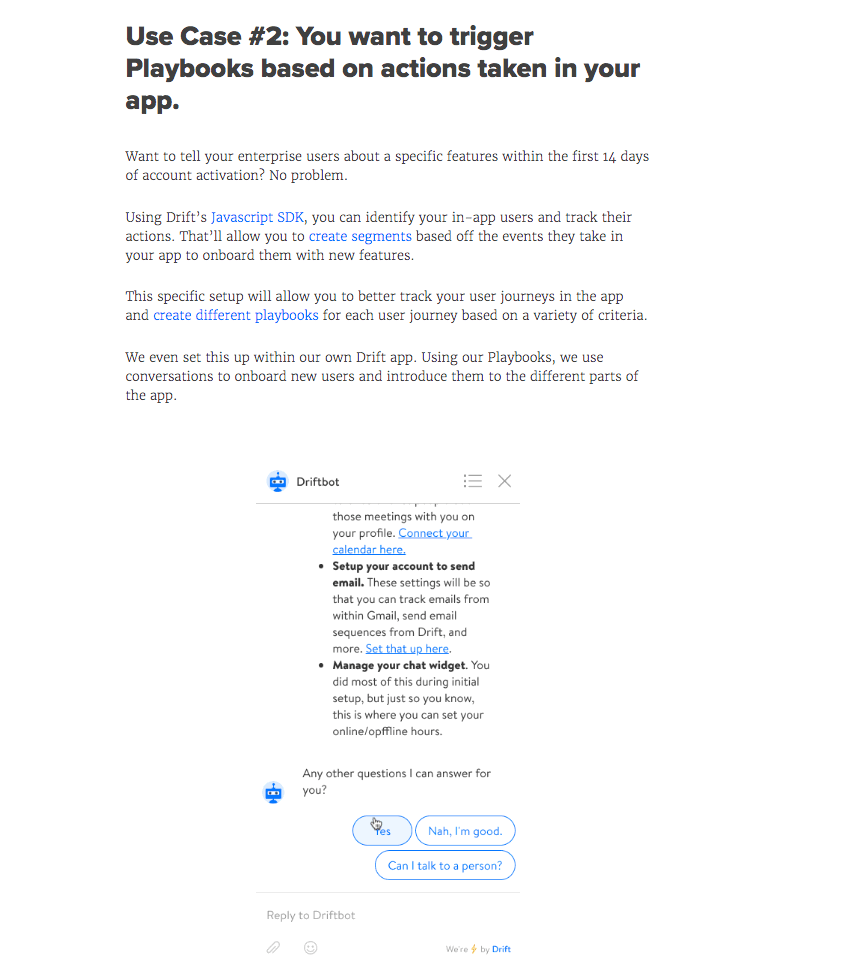Is your company currently using conversational marketing to create a better experience for customers?
What is Conversational Marketing?
Conversational marketing is a one-on-one approach which allows you to move more consumers down the sales funnel quicker. Consumers also feel more of a connection to your brand when the interaction is more humanized.
Rather than encouraging potential customers to complete a form on your website with their information/what they’re looking for, conversational marketing allows for immediate communication and targeted messaging where and how customers want. Examples include chatbots, texts, Slack, Facebook Messenger, etc.
These numerous forms of instant communication have a way of eliminating the barriers between customer support, sales, and marketing.
Elements/Features
Are you thinking your company is already utilizing conversational marketing since you’re present on multiple channels? You might be close!
Here are some of the key elements to understand and incorporate into your strategy:
1. Conversations Convenient for Customers
Different customers will want to communicate with your brand at different times depending on what’s convenient in their schedules. It’s crucial for businesses to be able to talk to customers in real time, but it’s also important to continue that conversation at the pace the customer sets. For example, they may be able to chat some before work then again that night after their children have gone to sleep. Understanding this and having the proper tools in place to make this work is an essential part of conversational marketing.
2. Scalability
Consumers aren’t concerned with how many others you’re talking with, as they only care about their business/the issue they need to be resolved. Bots can allow for 24/7 support while saving your employees’ valuable time.
3. Context in Conversations
As a conversation with a consumer progresses, one would expect the context to get smarter. For example, if someone has a question about an order one day then another question about a missing part in that order, he/she will expect the company to have the previous interactions and information already given available. Customers don’t want to waste time giving an order number and background information again.
Gathering data, developing an understanding of it, storing it, and having it accessible are important parts of using a chatbot system to make the conversational marketing process run smoothly.
4. Channels Convenient to the Customer
What channels are your customers using? Both Inbound Marketing and conversational marketing are about meeting customers where they are and providing value. Many people would rather communicate via bots, Facebook Messenger, etc. than have to call a number and wait on hold to talk to someone.
How well do you know your customers? Building a customer persona allows for a more targeted approach in your marketing strategy. Keep your customer in mind at all times, and make efforts to make all communication smooth and convenient.
5. Personalization
Even the first interaction with a customer can have a personal touch. One of the most basic options would be to have a chatbot conversation popup and say, “Hey, this is (name). Let me know if you have any questions.” You can also use tools such as IP address matching to insert the name of the company for which the person works. Competitors of that customer’s company could then be referenced to grab the person’s attention.
6. Built-In Customer Feedback
Businesses are always looking for more feedback from consumers, and conversational marketing can offer a built-in feedback loop where consumers share their opinions so you can determine what is or isn’t working.
Process Involving Chatbots – Here are a few examples of what a chatbot can do for your business:
- Answer common questions on which data is already available
- Qualify Leads
- Promote events, products, and content
- Book meetings
- Gather feedback from potential or current customers
A consumer will visit a website, and that information is captured by the company. That consumer may then choose to converse with a chatbot for various reasons, and the chatbot will use techniques to find out more about the customer/qualify them. In a B2B strategy, for example, a bot may then schedule a meeting for further discussion after determining a particular consumer is a quality lead.
Bots can also help direct the customer to the right department and save the time of your employees. They can also determine if someone just isn’t a good fit for your product to ensure you’re spending your quality time on leads that are more likely to make a purchase.
In comparison to forms, instant chats can seem more personal and yield more immediate communication to continue moving a consumer down the funnel to produce more sales in a shorter time frame.

Benefits of Conversational Marketing
It’s a proven technique to convert traffic into quality leads. Drift, the leading company in conversational marketing, refers to the methodology as “Capture, Qualify, Connect”.
1. Qualify leads in minutes rather than days – According to a study from Harvard Business Review, companies have to respond to customers within five minutes of initial contact to have the best chance of qualifying a lead. By waiting longer, the odds of qualifying that customer drop by 400%. Allowing bots to ask qualifying questions and gather more information allows you to spend time with only the best leads.
2. Give customers a better experience – Humanizing the process and making your website feel less like an empty store and more like a brand someone feels a connection with is a crucial part of customer satisfaction and building a stronger customer base. Improving customer support response times can also provide a better experience for everyone involved.
3. Learn more about your customers – Website forms often don’t provide as much information as an actual conversation can. Through real conversations, companies can gain a better understanding of what customers are often unsatisfied with, what customers are looking for, which products they enjoy the most, etc.
4. Produce sales quicker – Numerous companies have seen tremendous success concerning shortening the sales cycle when using conversational marketing. ThriveHive, for example, has seen their conversational marketing leads close at 2x the rate of their leads from other sources.
5. Increase sales pipeline – Half of Drift’s business is derived from conversational marketing. TreeRing’s pipeline increased 10% in the first two months of using conversational marketing, and conversations have influenced 25% of RapidMiner’s open sales pipeline, which is worth more than $1 million.
Changing the Buying Process
Put yourself in the shoes of your customers. Would you be more likely to purchase from a company who used these conversational marketing techniques and provided instant conversations to address your questions/concerns? Consider implementing a chatbot and other conversational techniques to help the buying process. It’s a win-win for both your business and your customers.
Future of Conversational Marketing
As technology continues to change, businesses and marketers have to adjust strategies to continue to be able to reach and interact with potential customers. According to RadiumOne, 84% of digital content-sharing in the U.S. occurs outside of public social networks and away from marketers’ eyes.
This is where conversational marketing via AI (artificial intelligence) comes in handy. Chatbots and other AI tools are able to detect and react to patterns in a natural manner.
For better results, companies should consider using the active listening skills of top salespeople and create conversational funnels centered around consumers. Customers can tell you what they want as well as any issues they’re having, and your chatbot can gather this information and respond in a way that improves both conversion and customer satisfaction.
Before using AI, make sure your company has clearly defined your brand’s image, voice, values, etc. The bots should be able to communicate in a way that’s consistent with your branding.
Are you curious what types of people are talking with businesses? According to Drift, of the 50,000+ businesses using their platform, those in key decision-making roles are often the ones who connect with companies in real-time messaging.
“In terms of seniority, 41% of the people having conversations were executives. CEOs made up 7.1%.”
Even with chatbots, you don’t have to have an ‘all or nothing’ approach, and you don’t have to completely remove the traditional forms from your website. Companies often begin by adding real-time messaging as a second way to gather customer information. This gives people an alternative option in case they wish to talk with someone immediately.
Applications with Zight (formerly CloudApp)
Zight (formerly CloudApp)’s screen recorder allows companies to share information quicker via visuals instead of typing everything. Videos are also more digestible and give clear information. Drift uses Zight (formerly CloudApp) to share visuals and answer customer questions directly in the Driftbot chat with a Zight (formerly CloudApp) link.

Conversational marketing involves establishing personal connections with customers while gathering and supplying information in a natural way.
Learn more about Zight (formerly CloudApp) for Marketing here.
